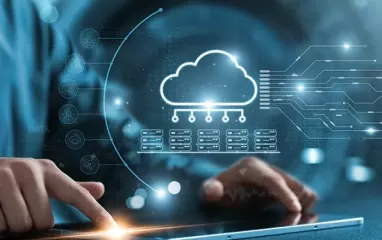Other recent blogs



Let's talk
Reach out, we'd love to hear from you!
Zero trust is a security model that doesn’t rely on predefined trust levels. It assumes that all users, devices, and networks are untrusted and potential threats.
Zero trust security models were created in response to the changing landscape of cybersecurity threats. As more businesses move to the cloud and adopt Bring-Your-Own-Device (BYOD) policies, it has become easier for attackers to gain access to sensitive data. Zero trust security helps mitigate these risks by continuously verifying identities and inspecting traffic, regardless of where users are located or which devices they use.
Zero trust security can be applied to any organization, but it is particularly well-suited for organizations with high levels of sensitive data or large networks of users and devices. Organizations adopting Zero trust security can improve their overall cybersecurity posture and protect their data and systems from malicious actors.
Why was Zero Trust security created?
Before the zero trust methodology, organizations believed that more threats came from a foreign entity lurking outside the security walls. The main problem with this school of thought was that insider breaches were as real as external threats.
The risks from somebody inside the company are always higher than those from outsiders. Moreover, such attacks could come even more conveniently.
The zero-trust model ensures that anyone accessing the company's network is who they say they are and limits their ability to roam the network freely. This model makes it impossible to harm because user access is restricted, and the activities are tracked throughout the time logged in.
Zero trust security aims to reduce the risk of cyber attacks by requiring strict verification for all users and devices before allowing access to sensitive data or systems. It is designed to be highly resilient to cyber attacks, making it more difficult for attackers to exploit vulnerabilities.
How does Zero Trust security work?
The goal of Zero trust is to provide security by verifying the identity of users and devices before allowing them to access data or systems.
Zero trust security starts with identifying which users and devices need access to which data and systems. Once this has been determined, users and devices are authenticated and authorized to access these resources. Zero trust security uses multiple layers to protect data and systems, including firewalls, intrusion detection and prevention methods, and encryption. Organizations can use Zero trust security to protect their data and systems more effectively from cyberattacks.
Once access is granted, zero trust security keeps tabs on user movements and uses analytics to pick up on potential threats and areas of anomaly.
For example, say an employee was given access to their work files on the company's network while working from home. The employee then takes their work computer to a new location and uses a new Wi-Fi. The zero-trust security will pick up on these changes and begin tracking the user's movements while logged in. The cybersecurity system will evaluate the changes to ensure that no likely risks are coming from the device's new location while the user is accessing the company files.
Another example of how zero trust security works is if a user attempts to access files unrelated to their project. Again, the system will note this as a potential threat and act accordingly.
An overview of Zero Trust security principles
Zero trust security is based on principles that ensure the safety of its users, consumers, and the overall company. These principles include:
- Trust no initial login and always assume that any user is hostile and threatens the network.
- Every network, device, and the user is authorized with every use.
- Only allow access to documents and resources necessary to complete a specific task.
- Secure company data and endpoints.
- Assume that there may always have been a hidden breach in the network.
These principles ensure no possible threat can pass through security measures. Movements are limited and tracked, and all users undergo extensive authorization before being given access. The system continuously looks for dangers.
Important Zero Trust security elements
A zero-trust security system is designed and put in place to mitigate internal and external threats to the network holistically. The system works on many levels and prevents potential hazards that other security systems may miss.
So, What are the advanced elements of Zero Trust security?
- Identity verification and authorization: Zero trust security focuses on a multi-layer verification process. Any user who wants access to a network must pass through all the security layers before being allowed inside. In addition, the system will enable the user to verify their identity as they move throughout the network. It does not matter how often the user has been granted access in the past; zero trust security will only allow access to individuals once their identity has been proven.
- The reinforcement of endpoints and data: The zero trust model recommends that every device be secured appropriately. Without the use of an appropriately secured device, zero trust will not allow users to gain access to the network. Even after users are granted access to the network, they will continue to be evaluated as they move through different parts of the company's web. For example, the user may be permitted access to the customer contact files but will have to undergo additional screenings and verification to retrieve their financial information.
- Control systems for analytics: Analytics are recorded to ensure that the zero trust system works at its highest capacity. The information gathered is used to monitor the network, resolve issues, and detect false positives. The data is also stored on a portal that can be accessed and evaluated further when needed.
- Anomaly detection: The goal of anomaly detection in Zero Trust Security is to identify potential security threats early on and to prevent authorized access to systems and data. Anomaly detection algorithms are based on machine learning or rule-based methods, and can analyze various aspects of an access request, such as the device being used, the IP address of the requestor, the time of day, or the type of resource being requested. By detecting anomalies and flagging suspicious activity, Zero Trust security helps prevent data breaches and unauthorized access to sensitive information, while also improving the overall security posture of an organization.
- Security Automation: Automation is an efficient resource to enhance cybersecurity. With automation, human error can be avoided, and more threats will become visible to the system. If a risk is detected, the system will routinely handle the issue and block any potential dangers from entering the network. This constant automatic scanning of the network avoids hidden dangers from getting through the walls and damaging the web or accessing confidential information.
- Forensic auditability: Forensic auditability refers to the ability of performing thorough investigations in the event of a security breach or suspicious activities. In a Zero Trust security model, every access request is verified before being granted, regardless of the location of the requestor or the device being used. This approach helps to increase the security of systems and data, but also requires a robust audit trail to be maintained so that any suspicious activities can be investigated and remediated. A forensic audit trail includes detailed information about the requestor, the device used, and the requested resource, as well as any actions taken in response to the request. This information proves essential for security teams to conduct a thorough forensic investigation in the event of a breach or a suspicious movement.
Zero Trust security thrives on context
Context is paramount when implementing Zero Trust Security. It is more than just information received about a user and his device. It highlights conditions under which this user in question should or should not be allowed to access a network or allowed access with certain limitations.
We can understand what context means by looking at an example. Suppose a user is trying to access a network. Information will include details about the device, the user, and the data they are trying to access. However, in the case of the context, the device’s location and whether or not this user needs the data he’s trying to access will be gauged before trust can be established.
In simple terms, a user accessing a system from a trusted location (e.g., their office) will have different levels of access than a user accessing the same system from an untrusted location (e.g., a public Wi-Fi network). That said, zero trust security is a powerful tool, but it must be used in the right context to be effective.
The challenges of shifting to Zero Trust
In theory, zero trust security is airtight. But in practice, some challenges must be considered before making the switch.
- Cultural gaps: One of the challenges companies may face when adopting a zero trust security posture is that it can take time to get buy-in from other organizational members. This is because zero trust security requires a complete rethink of how organizations approach security, and this can be a tough pill for some people to swallow. Furthermore, zero trust security can be expensive, often requiring investing in new technologies and tools.
- Micro-segmentation: In a standard, perimeter-based security set-up, users are placed into broad categories—for example; all employees might have access to the company intranet, while only certain employees might have access to the customer database. But in a zero trust security model, those access levels must be much finer-grained. This process is called micro-segmentation, and it’s crucial for achieving proper zero trust security. Micro-segmentation can be challenging to implement because it requires careful planning and execution, and organizations must understand what users need access to and configure the network accordingly. It can be time-consuming, but it is worth the increased security micro-segmentation provides.
- User authentication: Ensuring all users and devices are authenticated and authorized before they are granted access will be arduous. Traditionally, authentication is done using passwords or physical tokens such as keys or ID cards. However, these methods will be needed to ensure secure access. Organizations must implement robust authentication methods such as two-factor or biometric authentication for zero security. They must also set up an authorization system that defines what each user or device can access, which can be complicated.
- Slow- and predictable-moving workflows: Zero trust security can slow down access to critical data and systems, as every user and device must be authenticated and authorized before being granted access. This can create frustration among users who are used to having unrestricted access to data and systems.
- Legal and regulatory compliance: Legal and compliance protocols such as HIPAA may discourage organizations from adopting the zero-trust model. Even if the c-suite votes to embed zero trust in the organizational fabric, compliance officers may warn of some showstopping concerns before shifting to a new technological ecosystem.
- The boomerang effect: Finally, zero trust security is only as strong as its weakest link. So, if even one user falls for a phishing attack or misconfigures their device, it can expose the entire organization to vulnerabilities and cyber attacks.
Zero Trust is the future: A disruptive force heading our way
The zero trust approach has grown in popularity recently, as traditional security models have proven inadequate in protecting against sophisticated attacks. Going forward, it is likely that zero trust security will become increasingly important as organizations look to build more secure and resilient systems. While challenges are associated with implementing zero trust security, such as the need for strong identity management, the benefits outweigh the drawbacks.
In a world where data breaches are becoming more common and cyberattacks are becoming more sophisticated, zero trust security is vital for protecting information and ensuring resilience.



